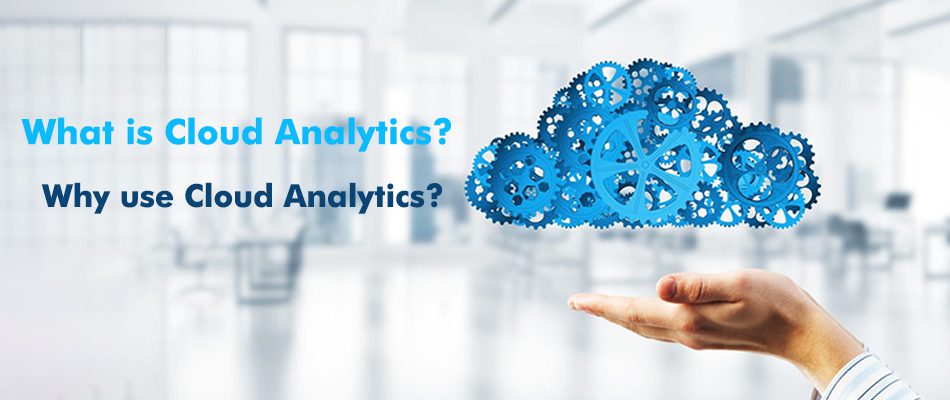Cloud is one of the most trending buzz words in the tech world and along comes various others terms too such as cloud analytics. Any business involved in producing and using a data set of any type knows about cloud analytics and thus, it is considered to be one of the leading fields to get into today.
Cloud analytics is all about data collection, data analysis, and data tracking taking place on a system hosted in the cloud as opposed to an on-premises system. Cloud- based analytics tools has been helping companies in wrangling huge data sets to facilitate them in improving their business results. Its use cases are almost endless and prevalent in all leading companies of the top domains.
With this blog, we will cover what is cloud analytics and why use cloud analytics. Also, if you are an aspiring student or a professional seeking to make the most of today’s trends, then this is where you will get the name of the institute that will help you get started in this direction.
What is Cloud Analytics?
Understanding cloud analytics is not a highly difficult task. Cloud analytics lies on the lines of analysing and manipulating data in the cloud, rather than doing it in an on- premises system. With the aid of the analytics systems that as been hosted in the cloud, users get empowered to aggregate, utilize, access, and analyse data. It is with the aid of such platforms that users gain the ability to work with humongous data sets, focus on areas that need improvement and know better about the trends that will help the organization.
Cloud analytics comes into play when we talk about companies that need to process their data sets ranging from tens of thousands to even millions of inputs. With such huge numbers and data, on- premises analytics fail to do their magic and also turn out to be heftier and more expensive.
What are Cloud Types?
Many believe cloud to be an intangible entity but it is actually a term used for huge computer networks that are hosted in data centres, which might be one or more. There are quite a lot of factors that play a part when it comes the time for companies to decide which type of cloud, they wish to choose including access needs, security level, goals and performance.
Let us discuss the top three cloud types –
- Private Cloud –
An on- demand computing system, a private cloud is only accessible when the user is inside the private network. Such clouds are not shared with another organization and work in a fashion quite similar to a company’s intranet.
Any cloud can become a private cloud if its underlying IT infrastructure is moulded to be dedicated to only one customer and hundred percent isolated access. Such clouds are much preferred by companies that wish to gain more on- demand services, heightened visibility into resources spanning across the infrastructure and better infrastructural capacity for handling huge data storage.
While the cost incurred to set up as well as maintain the applications and the networks might be a little higher than the servers in a public domain, there is definitely additional security.
- Public Cloud –
When a third- party provider offers a platform over the public internet, it is referred to as public cloud. These are available to all those who wish to use or purchase them. A standard cloud computing model is employed to make resources such as applications, storage and virtual machines, all of which are available to be used by remote users.
Some of the most commonly known available and used public cloud resources are shopping apps, SaaS (software as a service) applications and websites. It is cheaper as compared to a private cloud but also offers comparatively less security.
- Hybrid Cloud –
The perfect solution for those who wish to use the best of both the worlds is a hybrid cloud. When one private cloud is combined with one or more public cloud services, we come to enjoy the benefits of a hybrid cloud. Proprietary software is used to facilitate communication amongst each distinct service.
A hybrid cloud strategy can work wonders including consolidating IT resources, incorporating a unified management tool, connecting various computers via a network and shift workload from one environment to another.
How does Cloud Analytics Work?
Cloud analytics systems need to be hosted on a cloud or an internet platform. Since they are run on humongous data centres, they are always getting the needed storage space and the processing power which is a must to analyse gigantic amounts of data.
Basically, all that is generated is further collected and stored on cloud, which is then accessible from anywhere in the world from an internet- connected device. With the aid of proprietary algorithms, the data can be organized, analysed, cleaned and processed by the cloud analytics system.
While every cloud analytics solution presents it own set of features, there are certain common components witnessed in all of these. Here is a list of those shared components –
- Computing Power – Sufficient computing power is required by the cloud analytics to clean, analyse, intake and structure big volumes of data.
- Data Sources – Business data originates from a lot of various sources including ERP systems, social media data, web usage data and CRM systems.
- Analytic Models – Analytics models refer to the mathematical models employed for the analysis of complicated data sets and to extract a prediction out of them.
- Data Models – The role of a data model structure is to retrieve and standardise the line between how data points relate to one another to be analysed. Models can be of two types – simple or complex.
- Data Sharing and Storage – Cloud analytics solutions are known to offer data warehousing as one of its key services to facilitate easy and quick scaling of businesses.
- Processing Applications – Special applications are used by cloud analytics to facilitate processing of large data volumes of information that have been stored in the data warehouses.
Why Use Cloud Analytics?
Cloud analytics has been known to render huge impacts on an organization with its multitude of benefits. If you are wondering why cloud analytics is used so widely by both small and big businesses alike, then this is where you will find the answer you are looking for.
- Security
Security is something companies are always working hard for. While this area also falls under the lookout of a company’s IT staff, the ones who are constantly working to achieve it are cloud hosts. Robust encryption is used to secure data that is transmitted across networks by the cloud analytics providers. Since the data is stored offsite, an added advantage is achieved.
- Scalability
Cloud analytics services allows organizations to scale up and down to accommodate the spikes or falls in demand by bringing forth more instances online or reducing them as per the situation. This way, the user is only paying for what is being used.
On the contrary, administrators running on- premise platforms need to purchase and install additional hardware whenever data volumes or workloads grow. This leads to over spending, throwing the budget off the hill and also leads to over provisioning.
- Data Consolidation
Since data is collected from various sources disparate in nature, it becomes a bit difficult to get a unified view of the same. With the aid of cloud analytics, an organization gets a place to bring all its data sources together, leading to a bigger, more complete picture getting formed.
This also allows all the stakeholders, wherever they may be, to access all this data at one place, get clear insights and therefore, make better informed decisions in due time.
- Cost Reduction
Cloud analytics has been known to provide a huge relief when it comes to managing cost and expenses. Organizations are not only spared from having to go through the cost of purchasing and supporting added hardware but also can choose to get the in- house expertise of service providers.
With on- premise platforms, frequent migrations and frequent upgrades come along the deal. And this is in addition to the high cost of the multiple hardware requirements. These frequent happenings also lead to system downtimes that have been known to negatively affect the business continuity.
- Sharing and Collaboration
With cloud analytics solutions, data from the various parts of an organization can be integrated in a better way to lead to stronger communication and finally leading to finer decision making. Hence, the entire business grows together and not in portions of mere departments.
Conclusion
It is a well- known fact that anything to do with cloud is bound to stay and flourish in the longer run. If you have inclination towards this field and you think you can do your best here, then the best path you can tread on now is one that has been walked before by various other students who have completed their AWS training and certification from Grras Solutions.
It is with the right training from experts that you gain confidence, knowledge, skills and the ability to perform tasks needed to be completed and with utmost precision. Get more details on the course by getting on a call with our guidance counsellors.






